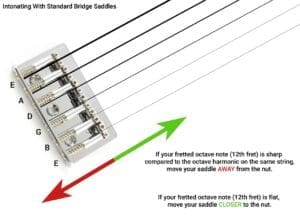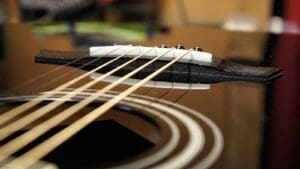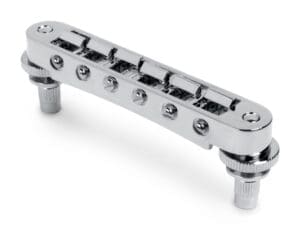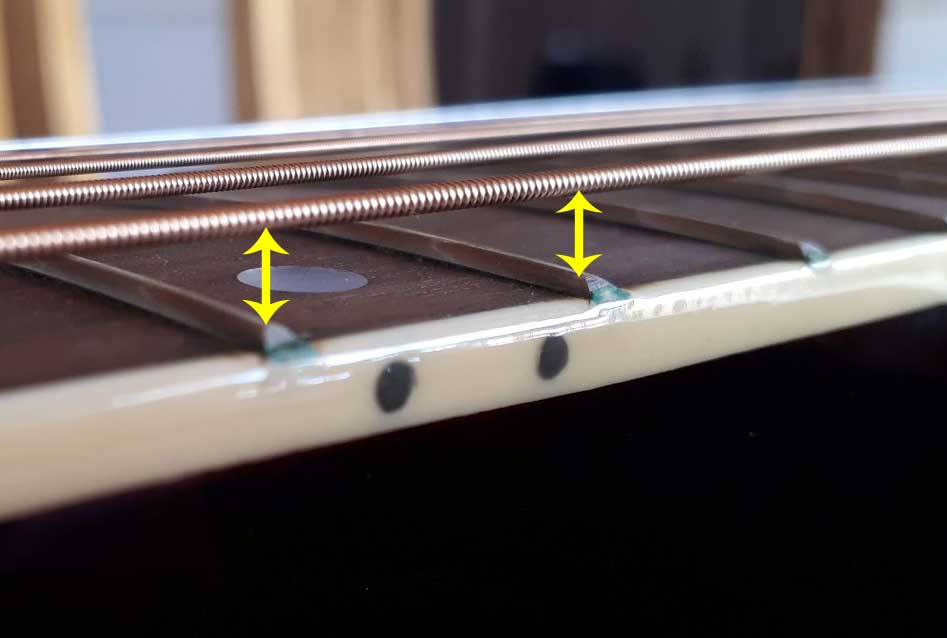Last update 5/2/2024
In this article, we will delve into the topic of a guitar’s action or guitar string height, explore its significance, and offer insights on achieving the ideal balance for your playing style.
Table of contents
Guitar String Height
As a guitarist, you understand the importance of your instrument’s feel and playability. It can be frustrating when issues impede your ability to bend notes smoothly or accurately fret them without exerting excessive force. One potential cause of these problems is high action on your guitar.
Let’s begin by clarifying what we mean by “action” in the context of guitars. A guitar’s action refers to the strings’ height above the fingerboard. It is a critical factor that directly affects playability and the overall feel of the instrument. High action means the strings sit relatively high above the fingerboard, requiring more effort to press them down and fret notes properly. Conversely, low action implies that the strings are positioned closer to the fingerboard, making executing techniques like bending and fretting easier.
Does your guitar have a high action?
Determining whether your guitar has high action involves considering several factors. First and foremost, pay attention to how your instrument feels and responds. Are you facing difficulties bending strings or struggling to fret notes accurately? These signs may indicate that your guitar has high action. Additionally, be mindful of any buzzing or rattling sounds during play, as they can suggest low action, causing the strings to vibrate against the frets.
While there are no fixed rules for the ideal action height, finding a balance that suits your playing style and preferences is generally recommended. Remember that your guitar’s action is a matter of personal taste, and what works for one guitarist may not work for another. However, there are some guidelines and industry standards that can serve as a starting point in your quest for optimal playability. NOTE: It is common practice for slide guitar players to raise the action of their guitars to avoid sting buzz for that style of playing.
How to check the guitar’s action


To measure your guitar’s action, you can use a ruler or specialized tools designed for this purpose. The 12th fret is the most commonly used reference point, situated precisely halfway between the guitar’s nut and bridge. Measure the distance between the bottom of the strings and the top of the 12th fret to get an idea of your current action height. It’s important to note that different guitar manufacturers and models may have specific recommendations for action height, so consult your instrument’s documentation or reach out to the manufacturer for guidance.
Optimal action height
Let’s now explore the factors that can influence the optimal action height for your guitar. One crucial aspect is your playing style and the techniques you primarily use. For example, if you frequently bend strings as a blues or rock guitarist, you may prefer lower action to facilitate smooth and effortless bending. Conversely, if you play slide guitar or like a heavier attack with more aggressive picking, higher action might be preferable to prevent unwanted string buzzing against the frets.
Enthusiasm is everything. It must be taut and vibrating like a guitar string. Pele
String gauges


Another factor to consider is the gauge of strings you use. Heavier gauge strings naturally exert more tension on the guitar’s neck and can cause it to bow slightly. Higher action may be necessary to accommodate the additional tension in such cases. On the other hand, lighter gauge strings exert less tension, allowing for lower action without fret buzz.
What about neck relief
The neck relief, or the curvature of the guitar’s neck, can also impact the action height. A neck with an excessive forward bow (convex curvature) may require higher action to prevent string buzzing against the frets. Conversely, a back-bowed neck (concave curvature) can result in higher action due to the increased distance between the strings and the frets.
High action
Now that we understand the various factors at play, let’s discuss the potential implications of high action on your playing experience. When the action is too high, pressing the strings down onto the frets requires more force. This can be physically tiring and may cause discomfort or pain in your fingers and hands during extended playing sessions. Moreover, the extra effort required to fret notes accurately can negatively affect your technique, speed, and fluidity. It may limit your ability to execute advanced techniques like legato playing, sweep picking, or intricate chord voicings.
Your guitar’s intonation


In addition to the physical challenges, high action can also impact your guitar’s intonation. Intonation refers to the accuracy of the guitar’s pitch along the entire length of the neck. When the action is too high, bending the strings more to reach the frets can cause them to stretch further, potentially resulting in intonation issues. Specific notes may sound out of tune, especially when playing higher up the neck.
Lowering the action
On the other hand, it’s worth noting that lowering the action to an extreme level can also have drawbacks. While low action can offer enhanced playability, allowing for faster and smoother fretting, it increases the risk of string buzzing against the frets. When the strings are too close to the frets, they can vibrate against them, producing an undesirable buzzing or rattling sound. This buzzing affects the sound quality and can disrupt your playing, undermining confidence in your performance.
Getting the action right
Finding the perfect balance between action height and avoiding fret buzz requires careful adjustment. Depending on your guitar’s design, you can change specific components to modify the action. The primary areas to focus on are the saddle height and the bridge.
Saddle height


Adjusting the saddle height involves raising or lowering individual saddles to change the action for each string. Most electric guitars have adjustable saddles that allow for fine-tuning the action to suit your preferences. Acoustic guitars often have a single compensated saddle, which can be adjusted as a whole.
To adjust the saddle height, you will need the appropriate tools, such as an Allen wrench or a screwdriver, depending on the type of saddle adjustment mechanism your guitar employs. Proceed with caution, as even minor adjustments can noticeably impact the action. Make incremental changes, test the playability, and assess the result. It’s a process that requires patience and experimentation to find the sweet spot that works best for you.
Your guitars bridge


The bridge height can also affect the action. Electric guitars with a floating bridge or a tremolo system allow for adjusting the overall height of the bridge. By raising or lowering the bridge, you can simultaneously achieve a slight change in the action across all strings. This adjustment may require more care and expertise, so if you need clarification, it’s always advisable to seek assistance from a professional guitar technician.
While adjusting the action through saddle and bridge modifications can be effective, it’s essential to understand that making significant changes to the action height can lead to other adjustments becoming necessary. For instance, lowering the action too much may require adjusting the guitar’s truss rod to counterbalance the decreased string tension.
The truss rod is a metal rod that runs inside the guitar’s neck and allows for adjusting its curvature. Manipulating the truss rod should be done with caution and is best left to experienced guitar technicians who can ensure proper adjustment without causing damage to your instrument.
Consequences of changing the action
Additionally, changing the action height can impact other elements of your guitar’s setup. Lowering the action may result in the strings being closer to the magnetic pickups, potentially affecting their balance and output level. This may necessitate adjusting the pickup height or swapping pickups to maintain the desired tone. The change in string height can also affect the setup of your guitar’s nut, requiring adjustments to ensure proper string clearance and avoid string binding or buzzing in the nut slots.
It’s essential to keep in mind that adjusting the action is not a standalone modification. It’s part of a broader setup process considering other factors such as neck relief, intonation, pickup height, and overall playability. Therefore, it’s advisable to approach action adjustments as part of a complete setup to ensure the best possible outcome.
When modifying the action, being patient and making incremental changes is crucial. Start with small adjustments and evaluate their impact on playability and sound. Remember that the optimal action height is subjective and may vary based on your playing style, musical genre, and personal preferences.
If you need further clarification on making action adjustments yourself, it is highly recommended to seek the assistance of a qualified guitar technician. They possess the expertise and specialized tools to accurately measure, make precise adjustments, and optimize your guitar’s setup for optimal playability and sound quality.
In conclusion
Your guitar’s action significantly affects your overall playing experience. Finding the perfect balance is crucial to achieving optimal playability, sound quality, and comfort. Whether your guitar’s action is too high, too low, or just right, it’s a personal journey that requires experimentation, patience, and potentially seeking professional guidance.
Remember, every guitarist is unique, and what works for one may not work for another. The goal is to find the action height that feels most comfortable and allows you to express yourself freely on the instrument. So, if you suspect your guitar’s action hinders your playing experience, don’t hesitate to explore adjustments and find your perfect balance.
Transparency disclosure: Some of the links in this post are affiliate links, meaning that I may earn a commission if you click on a link and make a purchase. This commission comes at no extra cost to you. We only recommend products and services that I believe are helpful and valuable, and we never let the potential for a commission influence our recommendations.
Amazon guitar setup tools.



